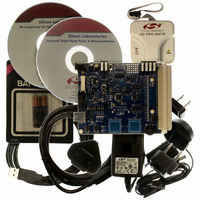C8051F930DK Silicon Laboratories Inc, C8051F930DK Datasheet - Page 145

C8051F930DK
Manufacturer Part Number
C8051F930DK
Description
KIT DEV C8051F920,F921,F930,F931
Manufacturer
Silicon Laboratories Inc
Type
MCUr
Specifications of C8051F930DK
Contents
Target Board, Power Adapter, USB Debug Adapter, Cables, Batteries, and Software
Processor To Be Evaluated
C8051F930
Processor Series
C8051F9xx
Data Bus Width
8 bit
Interface Type
I2C, UART, SPI
Maximum Operating Temperature
+ 85 C
Minimum Operating Temperature
- 40 C
Operating Supply Voltage
0.9 V to 3.6 V
Lead Free Status / RoHS Status
Lead free / RoHS Compliant
For Use With/related Products
C8051F920, F921, F930, F931
Lead Free Status / Rohs Status
Lead free / RoHS Compliant
Other names
336-1473
Available stocks
Company
Part Number
Manufacturer
Quantity
Price
Company:
Part Number:
C8051F930DK
Manufacturer:
Silicon Labs
Quantity:
135
- Current page: 145 of 324
- Download datasheet (3Mb)
C8051F93x-C8051F92x
13. Flash Memory
On-chip, re-programmable Flash memory is included for program code and non-volatile data storage. The
Flash memory can be programmed in-system through the C2 interface or by software using the MOVX
write instruction. Once cleared to logic 0, a Flash bit must be erased to set it back to logic 1. Flash bytes
would typically be erased (set to 0xFF) before being reprogrammed. The write and erase operations are
automatically timed by hardware for proper execution; data polling to determine the end of the write/erase
operations is not required. Code execution is stalled during Flash write/erase operations. Refer to
Table 4.6 for complete Flash memory electrical characteristics.
13.1. Programming The Flash Memory
The simplest means of programming the Flash memory is through the C2 interface using programming
tools provided by Silicon Laboratories or a third party vendor. This is the only means for programming a
non-initialized device. For details on the C2 commands to program Flash memory, see Section “27. C2
Interface” on page 319.
The Flash memory can be programmed by software using the MOVX write instruction with the address and
data byte to be programmed provided as normal operands. Before programming Flash memory using
MOVX, Flash programming operations must be enabled by: (1) setting the PSWE Program Store Write
Enable bit (PSCTL.0) to logic 1 (this directs the MOVX writes to target Flash memory); and (2) Writing the
Flash key codes in sequence to the Flash Lock register (FLKEY). The PSWE bit remains set until cleared
by software. For detailed guidelines on programming Flash from firmware, please see Section “13.5. Flash
Write and Erase Guidelines” on page 150.
To ensure the integrity of the Flash contents, the on-chip VDD Monitor must be enabled and
enabled as a reset source in any system that includes code that writes and/or erases Flash mem-
ory from software. Furthermore, there should be no delay between enabling the V
Monitor and
DD
enabling the V
Monitor as a reset source. Any attempt to write or erase Flash memory while the
DD
V
Monitor is disabled, or not enabled as a reset source, will cause a Flash Error device reset.
DD
13.1.1. Flash Lock and Key Functions
Flash writes and erases by user software are protected with a lock and key function. The Flash Lock and
Key Register (FLKEY) must be written with the correct key codes, in sequence, before Flash operations
may be performed. The key codes are: 0xA5, 0xF1. The timing does not matter, but the codes must be
written in order. If the key codes are written out of order, or the wrong codes are written, Flash writes and
erases will be disabled until the next system reset. Flash writes and erases will also be disabled if a Flash
write or erase is attempted before the key codes have been written properly. The Flash lock resets after
each write or erase; the key codes must be written again before a following Flash operation can be per-
formed. The FLKEY register is detailed in SFR Definition 13.2.
Rev. 1.1
145
Related parts for C8051F930DK
Image
Part Number
Description
Manufacturer
Datasheet
Request
R
Part Number:
Description:
SMD/C°/SINGLE-ENDED OUTPUT SILICON OSCILLATOR
Manufacturer:
Silicon Laboratories Inc
Part Number:
Description:
Manufacturer:
Silicon Laboratories Inc
Datasheet:
Part Number:
Description:
N/A N/A/SI4010 AES KEYFOB DEMO WITH LCD RX
Manufacturer:
Silicon Laboratories Inc
Datasheet:
Part Number:
Description:
N/A N/A/SI4010 SIMPLIFIED KEY FOB DEMO WITH LED RX
Manufacturer:
Silicon Laboratories Inc
Datasheet:
Part Number:
Description:
N/A/-40 TO 85 OC/EZLINK MODULE; F930/4432 HIGH BAND (REV E/B1)
Manufacturer:
Silicon Laboratories Inc
Part Number:
Description:
EZLink Module; F930/4432 Low Band (rev e/B1)
Manufacturer:
Silicon Laboratories Inc
Part Number:
Description:
I°/4460 10 DBM RADIO TEST CARD 434 MHZ
Manufacturer:
Silicon Laboratories Inc
Part Number:
Description:
I°/4461 14 DBM RADIO TEST CARD 868 MHZ
Manufacturer:
Silicon Laboratories Inc
Part Number:
Description:
I°/4463 20 DBM RFSWITCH RADIO TEST CARD 460 MHZ
Manufacturer:
Silicon Laboratories Inc
Part Number:
Description:
I°/4463 20 DBM RADIO TEST CARD 868 MHZ
Manufacturer:
Silicon Laboratories Inc
Part Number:
Description:
I°/4463 27 DBM RADIO TEST CARD 868 MHZ
Manufacturer:
Silicon Laboratories Inc
Part Number:
Description:
I°/4463 SKYWORKS 30 DBM RADIO TEST CARD 915 MHZ
Manufacturer:
Silicon Laboratories Inc
Part Number:
Description:
N/A N/A/-40 TO 85 OC/4463 RFMD 30 DBM RADIO TEST CARD 915 MHZ
Manufacturer:
Silicon Laboratories Inc
Part Number:
Description:
I°/4463 20 DBM RADIO TEST CARD 169 MHZ
Manufacturer:
Silicon Laboratories Inc











